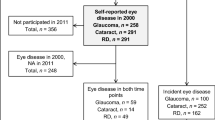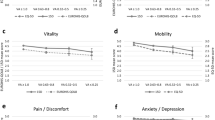Abstract
To evaluate the effect of impaired vision on health-related quality of life (HRQoL), the authors administered the Medical Outcomes Survey Short-Form 36 (SF-36) to the elderly in a metropolitan Taiwanese community and assessed their visual impairment status. A structured questionnaire was used for door-to-door data collection. Interviewers also collected information on demographics, medical history, and HRQoL. Those who were interviewed were invited to the study hospital for a detailed eye examination. An eye examination, including presenting visual acuity and best-corrected visual acuity, was conducted by ophthalmologists. Presenting visual acuity and best-corrected visual acuity were measured in the better eye. Impaired vision was defined as presenting visual acuity in the better-seeing eye worse than 6/12 (or 20/40) and was used to evaluate the correlation to HRQoL. A total of 1361 subjects at least 65 years of age participated in both the interview and eye examination. Internal-consistency and test–retest reliability of the eight scales were high. Based on the separate multiple regression model, after controlling for all other covariates, subjects in contact with vision services offered by an ophthalmologist had more positive scores on general health perceptions (β= 4.29; p < 0.001), vitality/energy (β= 2.73; p < 0.001), and mental health (β= 2.06; p= 0.01). Impaired vision was associated with significantly lower scores in physical functioning (β=−3.62; p < 0.001) and social functioning scales (β=−3.25; p= 0.015). The findings suggest that visual impairment is associated with lower quality of life and use of eye care services is associated with higher quality of life.
Similar content being viewed by others
References
Brazier JE, Harper R, Jones NM, et al. Validating the SF-36 health survey questionnaire: New outcome measure for primary care. Br Med J 1992; 305: 160–164.
McHorney CA. Health status assessment methods for adults: Past accomplishments and future challenges. Ann Rev Publ Health 1999; 20: 309–335.
Weih LM, VanNewkirk MR, McCarty CA, et al. Age-speci c causes of bilateral visual impairment. Arch Oph-thalmol 2000; 118: 264–269.
Rudberg MA, Furner SE, Dunn JE,et al. The relationship of visual and hearing impairments to disability: An analysis using the longitudinal study of aging. J Gerontol 1993; 48: M261–M265.
Rubin GS, Roche KB, Prasada-Rao P, et al. Visual impairment and disability in older adults. Optom Vis Sci 1994; 71: 750–760.
Lee PP, Spritzer K, Hays RD. The impact of blurred vision on functioning and well-being. Ophthalmology 1997; 104: 390–396.
Stelmack J. Quality of life of low-vision patients and out-comes of low-vision rehabilitation. Optom Vis Sci 2001; 78: 335–342.
Keeffee JE, Lam D, Cheung A, et al. Impact of vision impairment on functioning. Aust N Z J Ophthalmol 1998; 26: 16–18.
Carabellese C, Appollonio I, Rozzini R,et al. Sensory impairment and quality of life in a community elderly population. J Am Geriatr Soc 1993; 41: 401–407.
Deyo RA. The quality of life, research, and care. Ann In-tern Med 1991; 114: 695–697.
Ware JE, Sherbourne CD. The MOS 36-Item short form health survey (SF-36).I.Conceptual framework and item selection. Med Care 1992; 30: 473–483.
McHorney CA, Ware JE, Raczek AE. The MOS 36-Item Short Form Health Survey (SF-36): II.Psychometric and clinical tests of validity in measuring physical and mental health constructs. Med Care 1993; 31: 247–263.
Lee HC, Chiu FK, Kwok WY, et al. Chinese elderly and the GDS short form: A preliminary study. Clin Gerontol 1993; 14: 37–42.
Brink TL, Yesavage JA, Lum O, et al. Screening tests for geriatric depression. Clin Gerontol 1982; 1: 37–43.
Sheikh Javaid I, Yesavage Jerome A. Geriatric depression scale (GDS).Recent ndings and development of a shorter version. Clin Gerontol 1986; 5: 165–173.
Fuh JL, Liu HC, Wang SJ, et al. Poststroke depression among the Chinese elderly in a rural community. Stroke 1997; 28: 1126–1129.
Alden D, Austin C, Sturgeon R. A correlation between the Geriatric Depression Scale long and short form. J Gerontol 1989; 44: P124–P125.
Tielsch JM, Sommer A, Witt K, et al. Blindness and visual impairment in an American urban population.The Balti-more Eye Survey. Arch Ophthalmol 1990; 108: 286–290.
Attebo K, Mitchell P, Smith W. Visual acuity and the causes of visual loss in Australia. The Blue Mountains Eye Study. Ophthalmology 1996; 103: 357–364.
Ware JE, Kosinski M, Keller SD. SF-36 Physical and Mental Health Summary Scales: A User 's Manual. Boston: The Health Institute,1994.
Ware JE, Snow KK, Kosinski M, Gendek B. SF-36 Health Survey: Manual and Interpretation Guide. Boston: The Health Institute,1993.
Smeeth L, Iliffe S. Effectiveness of screening older people for impaired vision in community setting: Systematic review of evidence from randomised controlled trials. Br Med J 1998; 316: 660–663.
Lau JT, Lee V, Fan D, et al. Knowledge about cataract, glaucoma,and age related macular degeneration in the Hong Kong Chinese population. Br J Ophthalmol 2002; 86: 1080–1084.
Sinclair AJ, Bayer AJ, Girling AJ, et al. Older adults,dia-betes mellitus and visual acuity: A community-based case-control study. Age Ageing 2000; 29: 335–339.
Zhao J, Sui R, Jia L,et al. Visual acuity and quality of life outcomes in patients with cataract in Shunyi County, China. Am J Ophthalmol 1998; 126: 515–523.
Scott IU, Smiddy WE, Schiffman J,et al. Quality of life of low-vision patients and the impact of low-vision services. Am J Ophthalmol 1999; 128: 54–62.
West SK, Munoz B, Rubin GS, et al. Function and visual impairment in a population-based study of older adults. The SEE Project.Invest Ophth Vis Sci 1997; 38: 72–82.
Wang JJ, Mitchell P, Smith W, et al. Impact of visual impairment on use of community support services by el-derly persons: The Blue Mountains Eye Study. Invest Ophthalmol Vis Sci 1999; 40: 12–19.
Mangione CM, Lee PP, Pitts J,et al. Psychometric pro-perties of the National Eye Institute Visual Function Questionnaire (NEI-VFQ). Arch Ophthalmol 1998; 116: 1496–1504.
Klein R, Klein BE, Jensen SC, et al. The relation of socioeconomic factors to the incidence of proliferative diabetic retinopathy and loss of vision. Ophthalmology 1994; 101: 68–76.
Author information
Authors and Affiliations
Rights and permissions
About this article
Cite this article
Tsai, SY., Chi, LY., Cheng, CY. et al. The Impact of Visual Impairment and Use of Eye Services on Health-Related Quality of Life among the Elderly in Taiwan: The Shihpai Eye Study. Qual Life Res 13, 1415–1424 (2004). https://doi.org/10.1023/B:QURE.0000040791.87602.fe
Issue Date:
DOI: https://doi.org/10.1023/B:QURE.0000040791.87602.fe




